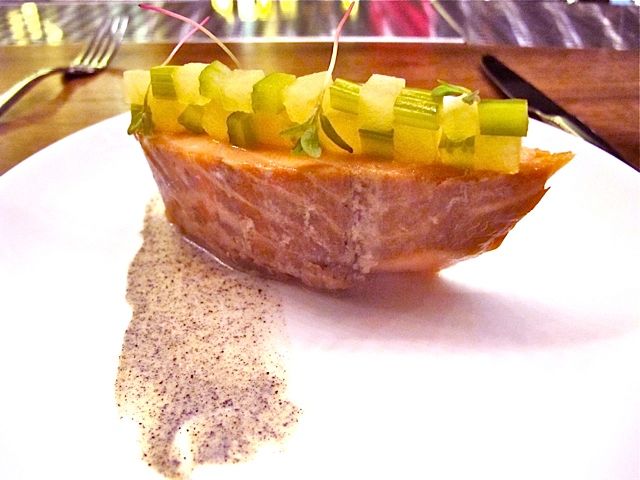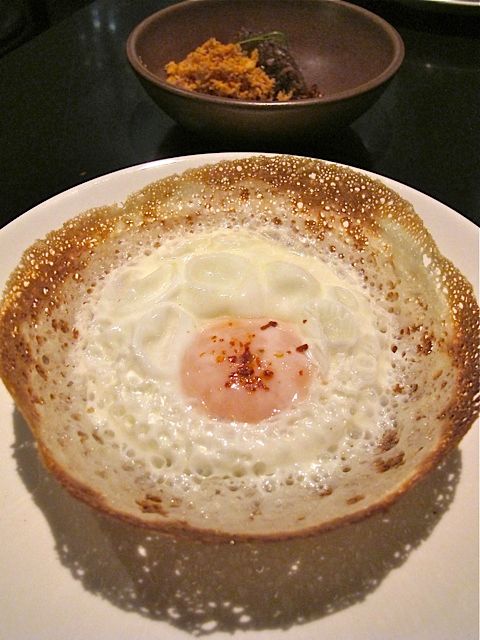There are some restaurants that make me want to be really sure everyone has tried it. I’m glad I have this column o’ mine, because I can tell you how much I am enjoying the food and vision at 1601 BAR & KITCHEN in SoMa.
Man, it’s a rough location—with very little food traffic at night—but bonus for you, because you’ll find Doris Day parking. As soon as you waltz into this corner restaurant, you’ll switch gears, entering a contemporary space with artistic touches and some whimsy too (love the brocade wallpaper in the back by the restrooms).
Designer Brent Kanbayashi placed a communal table in the front window (it should be the location of your next group dinner; with room for 10-12 guests, it’s almost like having your own room). Fortunately, there are plenty of two-tops in the back dining room, because it’s a great date place.
I also appreciate all the seats at the L-shaped bar, where I perched one evening when I was looking for a spur-of-the-moment bite. I ended up making friends with a couple who had the same idea. It’s the kind of food that will make you talk to your neighbor.
Chef-owner Brian Fernando has had some haute training (he worked at the well-regarded Le Papillon in San Jose), but this is his passion project. There is evidence of his elevated technique across the menu, which is a fascinating mix of (mostly) French with some Sri Lankan influences (Fernando’s father is Sri Lankan) and a California lightness. The menu is almost all small plates, so you’ll need to order at least a few dishes per person.
This is not a place for when you are stoned and famished and want to hork a double cheeseburger. But when you want to enjoy a meal and sink into some unique dishes and flavors, here’s your spot. I hate the word thoughtful when describing restaurants (“a thoughtful wine list”; trust, I had to strike it from my food writing vocab)—but the food here really is. You can sense that every component has been very considered.
The local halibut “ceviche” ($13)—which is more like a crudo—is an intriguing and silky start, bright with compressed cucumber and lime pickle that play against creamy coconut milk, plus some heat from thinly sliced serrano chile. It’s elegantly plated, and the flavors are very balanced. Or you can go for the poached octopus ($11), with smoked lime gelée that also gives a nice acidic slap to the palate—it’s not just a pretty plate, it has personality too.
Another dish that plays with the balance of acid and fat is the house-smoked salmon ($12), which Fernando marinates overnight and then smokes at a low temp. The tender, flaky fish comes with a crest—a little brick wall—of alternating pieces of compressed apple and celery, with the lightest vinegar pickling. Burnt onion crème fraîche is painted on the plate, but I wanted a touch more to make it worth being listed on the menu.
A must is the mulligatawny soup. (How many of us first learned about that soup because of Seinfeld? [Raises hand.]) It’s Fernando’s father’s recipe, but Frenchified. Chicken confit is crowned with pickled mustard seeds in the middle of the bowl, and there are elements of sherry and white wine in the deeply flavorful and peppery soup (and the whisper of cinnamon and turmeric), which is also rich with coconut milk. Damn tasty.
I had never had an egg hopper ($9), but you know I had to order it (egg + hopper = duh). It’s a lacy crêpe-like bowl made from lightly fermented rice flour and coconut milk. Within the edible basket is a stunning, soft-cooked Jidori egg—wait until you cut into the deep orange yolk. Top it with the flavorful sambols that come on the side (the katta is spicy with Sri Lankan chile, the pol is made with coconut, and the seeni is stewed onion). Since the hopper is technically street food, is should be folded like a taco and eaten out of hand, but you can also make it a fork-and-knife affair (I have attacked it both ways). You almost don’t want to share it. Pair it with the Calicraft Buzzerkeley that’s on tap, humina humina.
I am torn about some of the vegetable dishes: the preparation of the raw kale salad ($9) didn’t feel special enough compared with the many other stars on the menu, and while the browned cauliflower is full of wonderful flavor (and it’s even mellowed in a light brine), I can’t justify the $9 price tag for five florets with carrot and cumin purée. Better value is found in the flavor-packed fried heirloom potatoes ($7) and the fried okra ($8), which Fernando soaks in buttermilk so it’s not even remotely slimy; the accompanying cashew nut curry is also meaty and hearty—it’s kind of an awesome (and fulfilling) vegan dish.
Larger plates (they’re about the portion of what you’d get in a tasting menu at a fine restaurant) include the beautifully roasted squab ($17) with forbidden rice, and you have to try the braised sturgeon ($18), which is inspired by another one of Dad’s recipes (he would toast the spices until very dark for an intense powder that Fernando coats the fish in for two hours). Steak lovers, opt for the bavette ($21), with a demi-glace made from the seeni (onion) sambol, and pork belly fans, there’s a really tender-yet-crisp version ($15) here with chicharrones, bonus. The lamb and pork meatballs ($13) are good but save them for your second or third visit when you have tried other more exciting dishes first.
Dessert: the hands-down winner is the Ceylon tea semifreddo ($8), which reminded me more of a zabaglione with its creamy texture, smartly finished with a brûléed top.
There are so many details about the preparation of these refined dishes I don’t have room to include here. It’s kind of staggering what goes into each dish—I want Fernando to teach some cooking classes so I can see the hopper in action, and how he makes the sambols and curries, and all the pickling he does (example: each vegetable on the pickle plate has its own pickle). You’ll taste things and wonder, “Hmmm, what IS that?” You’ll discover a new pantry, with lime pickle, Maldives fish, and the wonder of Sri Lankan cinnamon.
The wine list is well composed and versatile, equally matched by the beer list (Fernando is a huge beer fan, and has chosen some cool international bottles). I dig all the vermouths and sherries they stock, and the aperitifs were right up my alley, like the Adonis ($9), with oloroso sherry, Cocchi Torino, and orange bitters.
There are many components of finer dining in the service: flatware is presented to the table in boxes, servers are agile with good pairing recommendations, and the coursing is very precise (just order—the kitchen will figure what to send out when). The well-chosen music (love the Frenchie numbers) helps keep things light, which makes me think a little more warmth and a little less formality in the space would serve it well—the service style is kind, but very polite. 1601 is a little like the new kid at school—it just needs to make a few more friends before it starts getting picked first for kickball. So go check it out, and then you’ll probably check it out again—it’ll be a good friend. Halibut “ceviche” with compressed cucumber, coconut milk, serrano chiles. Photo: © tablehopper.com.











